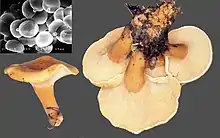Paralepistopsis acromelalga
Paralepistopsis acromelalga is a basidiomycete fungus in the Tricholomataceae family. It was formerly classified as Clitocybe acromelalga.[1]
| Paralepistopsis acromelalga | |
|---|---|
 | |
| Scientific classification | |
| Kingdom: | |
| Division: | |
| Class: | |
| Subclass: | |
| Order: | |
| Family: | |
| Genus: | |
| Species: | P. acromelalga |
| Binomial name | |
| Paralepistopsis acromelalga (Ichimura) Vizzini (2012) | |
| Synonyms | |
|
Clitocybe acromelalga Ichimura (1918) | |
| Paralepistopsis acromelalga | |
|---|---|
| Gills on hymenium | |
| Cap is depressed | |
| Stipe is bare | |
| Spore print is white | |
| Ecology is saprotrophic | |
| Edibility is poisonous | |
Taxonomy
It was first described in 1918 by the mycologist T. Ichimura and classified as Clitocybe acromelalga.[2]
The Paralepistopsis genus was created in 2012 by the Italian mycologist Alfredo Vizzini to better classify two rare toxic species formerly located in the Clitocybe genus and this species was subsequently reclassified.[3]
Habitat and distribution
It has been found in Japan and South Korea.[3]
Toxicity
It was discovered to be poisonous in 1918, when symptoms of mushroom poisoning occurred within three days of consumption. It had been mistaken for the edible tawny funnel cap (Paralepista flaccida formerly Lepista flaccida).[4]
Consumption of a related species, Paralepistopsis amoenolens, from France has resulted in the same condition.[5][6]
That species is commonly known as the paralysis cap and has been shown to contain acromelic acids including acromelic acid A which is a potent neurotoxin with a chemical formula of C13H14N2O7 and is associated with causing paralysis and seizures[7]
References
- "Species Fungorum - Paralepistopsis acromelalga (Ichimura) Vizzini, Mycotaxon 120: 261 (2012)". www.speciesfungorum.org. Retrieved 2022-07-19.
- "Species Fungorum - Clitocybe acromelalga Ichimura, Bot. Gaz., Chicago 65: 110 (1918)". www.speciesfungorum.org. Retrieved 2022-07-19.
- Vizzini, Alfredo; Ercole, Enrico (2012-09-28). "Paralepistopsis gen. nov. and Paralepista (Basidiomycota, Agaricales)". Mycotaxon. 120 (1): 253–267. doi:10.5248/120.253.
- Ichimura, J (1918). "A new poisonous mushroom". Bot Gaz (Tokyo). 65: 10911.
- Saviuc PF, Danel VC, Moreau PA, Guez DR, Claustre AM, Carpentier PH, Mallaret MP, Ducluzeau R (2001). "Erythromelalgia and mushroom poisoning". J Toxicol Clin Toxicol. 39 (4): 403–07. doi:10.1081/CLT-100105162. PMID 11527236. S2CID 32805160.
- Diaz, James H. (February 2005). "Syndromic diagnosis and management of confirmed mushroom poisonings". Critical Care Medicine. 33 (2): 427–36. doi:10.1097/01.CCM.0000153531.69448.49. PMID 15699849. S2CID 24492593.
- PubChem. "Acromelic acid A". pubchem.ncbi.nlm.nih.gov. Retrieved 2022-07-19.